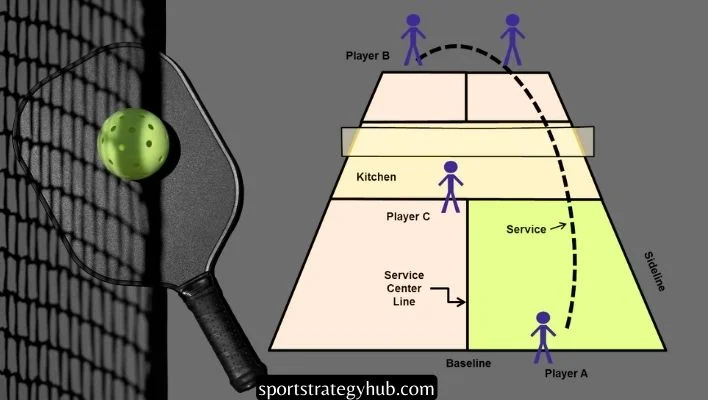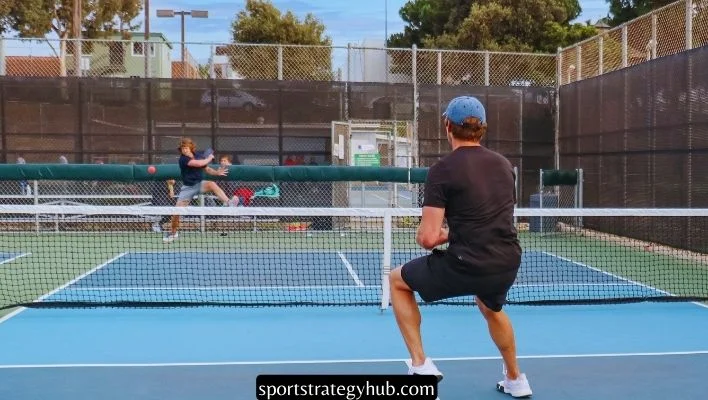How to score pickleball: Scoring Basics | Rules | Positioning
Pickleball, which blends features from badminton, table tennis, and tennis, is rapidly gaining popularity. To play competitively and have fun, it’s crucial for participants to grasp how scoring works in the game. In this comprehensive guide, we will break down the basics of pickleball scoring, explain the rules for both doubles and singles play, discuss player positioning strategies, and address common questions and misconceptions. Whether you’re a beginner or an experienced player looking to refine your skills, this article will provide you with the knowledge you need to confidently score pickleball games. Additionally, we’ll delve into specific techniques and strategies on how to score pickleball efficiently.
Pickleball Scoring Basics
Before we dive into the specifics of pickleball scoring, let’s cover some fundamental principles. In pickleball, a player or team must reach 11 points with at least a 2-point lead to win the game. This means that if the score is 11-9, the game is still ongoing until one team or player reaches a 2-point advantage.
Unlike some other racquet-type games, such as tennis, badminton, or ping-pong, points can only be scored by the serving team in pickleball. This makes a strong and reliable serve crucial for success in the game. Rallies, where the ball is hit back and forth after the serve and before a fault, are important for both the serving and receiving teams but do not result in points.
It’s important to note that while the serving team cannot directly score points, they must win back the right to serve in order to have the opportunity to score points and ultimately win the game.
See Also: How to play pickleball
Pickleball Doubles Scoring Rules
In doubles pickleball, where there are two players on each team, scoring works slightly differently than in singles play. In pickleball, only the serving team can earn points, and they must do so during their serve. When the game begins, the player positioned on the right side of the court serves diagonally across to the opposite side. The receiving team, on the other hand, never alternates sides.
Pickleball Singles Scoring Rules
In singles pickleball, the scoring rules largely mirror those of doubles, though there are notable distinctions. A singles match lacks a second server, meaning the serve consistently originates from the right side if the server’s score is even, and from the left if it is odd. It is the server’s score that dictates from which side to serve, not the receiver’s score. The receiver positions themselves on the corresponding side, matching the server’s. Scores are announced by stating the server’s score first, followed by the receiver’s score.
Player Positioning for Doubles Pickleball

Player positioning is a critical aspect of pickleball strategy, especially in doubles play. The standard positioning strategy in doubles involves one player staying near the baseline while the other player moves closer to the non-volley zone (NVZ) line.
This arrangement enhances court coverage and optimizes the strengths of each player. The player at the baseline typically has a stronger serve and groundstrokes, while the player at the NVZ line focuses on volleys and quick reactions at the net.
Pickleball Stacking Rules – Advanced Doubles Pickleball Positioning Strategy
Stacking is an advanced positioning strategy used by experienced doubles pickleball players to further optimize their strengths and minimize weaknesses. Stacking involves both players of one team lining up on the same side of the court, rather than one on the right and one on the left.
By stacking, players can take advantage of their dominant hand and positioning for better shot selection and court coverage. However, it is important to note that stacking is not allowed in all pickleball tournaments and may have specific rules and restrictions.
Player Positioning for Singles Pickleball

In singles pickleball, the positioning of players is simpler. Since there is only one player per side, the player must cover the entire court efficiently. The player should try to position themselves in the center of the court, allowing them to reach all areas quickly.
Good footwork and anticipation are crucial in singles play, as the player must cover a larger area on their own. By maintaining a central position, the player can respond to shots more effectively and minimize their opponent’s scoring opportunities.
When Do You Score a Point in Pickleball? Traditional vs. Rally Scoring
In pickleball, you can score points through either traditional scoring or rally scoring methods. With traditional scoring, only the team serving can earn points, and this happens when they win the rally during their serve. If the rally is won by the receiving team, no points are scored. Alternatively, rally scoring permits both the serving and receiving teams to score points, regardless of who serves. This method tends to result in quicker games and more frequent scoring opportunities. Whether to use traditional or rally scoring often depends on the competitive level, specific tournament regulations, or player preference. It’s crucial to agree on the scoring system before starting a match.
What Are Serving Numbers in Pickleball?
In pickleball doubles, serving numbers refer to the order in which each player on the serving team takes their turn to serve. The serving numbers are always 1 or 2, and they determine the sequence of service rotations.
The player on the right side of the court, when facing the net, is designated as the first server and will be the one to serve first during the team’s first turn to serve. In pickleball, the player on the left side of the court acts as the second server.
After each side out, where the serving team loses the rally and the serve transfers to the opposing team, the serving numbers remain the same, but the players switch sides. The player initially serving becomes the second server, and the roles are reversed.
What Are the Three Numbers in a Pickleball Score?
In pickleball, announcing the score involves three numbers. The first number is the serving team’s score, the second is the receiving team’s score, and the third shows the serving sequence, either 1 or 2. For instance, if the serving team’s score is 6, the receiving team’s score is 3, and it is the first server’s turn, the call would be “6-3-1.” The sequence for calling out scores is consistent: it starts with the serving team’s score, followed by the receiving team’s score, and ends with the serving order number.
How to Score a Doubles Game in Pickleball
Scoring a doubles game in pickleball involves keeping track of the score and announcing it correctly before each serves. Here is a step-by-step guide on how to score a doubles game:
- At the start of the game, the serving team announces the score as 0-0-2, indicating that the serving team has zero points, the receiving team has zero points, and it is the second server’s turn to serve.
- The first server initiates play by serving the ball from the right side of the court diagonally across to the opposite side.
- When the serving team wins a rally and earns a point, they change sides and the second server takes over as the first server. The score is announced in the following order: the serving team’s score, the receiving team’s score, and the serving order number.
- The game progresses as the serving team serves from the left side of the court diagonally across to the opposite side.
- This pattern of serving and switching sides continues until one team reaches 11 points with a 2-point advantage, winning the game.
How to Score a Singles Game in Pickleball
Scoring a singles game in pickleball follows a similar process to doubles scoring, with a few key differences. Here is how to score a singles game:
- Before each serve, the server declares the score, beginning with their team’s score and then stating the opponent’s score.
- The server serves from the right side when their score is even and from the left side when their score is odd.
- Only the player serving can score points. If the receiving player wins the rally, no points are awarded.
- The game goes on until a player scores 11 points and leads by at least 2 points, thereby winning the game.
Calling the Score in Pickleball
Correctly announcing the score is a crucial part of pickleball etiquette, promoting clarity and fairness in the game. The server is required to declare the score to the opponent and any onlookers before each serve. The correct order for announcing the score is the server’s score first, then the receiver’s score, followed by the serving number (1 or 2). For instance, if the serving team’s score is 4, the receiving team’s score is 2, and it’s the first server’s turn, the call should be “4-2-1.” This practice of consistent score-calling helps prevent confusion and disputes during play.
What Happens If the Wrong Score Is Called in Pickleball?
Mistakes can happen, and if the wrong score is called in pickleball, it’s important to rectify the error as soon as possible. If a player realizes that the score has been called incorrectly, they should immediately inform their opponent and the referee, if present.
The correct score should then be announced, ensuring that both teams are aware of the accurate score. Failure to correct a mistake in the score could lead to confusion and potential unfairness in the game.
Asking the Referee the Pickleball Score

In official pickleball matches with a referee, players can ask the referee for the current score if they are unsure. The referee will have been keeping track of the score and can provide an accurate update.
It is important for players to take responsibility for keeping track of the score themselves, but if there is any doubt or confusion, they can politely ask the referee for clarification. This ensures the game remains fair and transparent.
See Also: How to play pickleball on a tennis court
FAQs
In pickleball scoring, you announce the score of the serving team first and then the score of the receiving team. You follow this by stating the server number to clarify whether it is the first or second server serving. For instance, suppose the serving team has 3 points and the receiving team has 2 points. If it’s the turn of the second server, you would announce the score as “3-2-2.”
The score “0-0-2” in pickleball means that neither team has scored any points. It is now the second server’s turn to serve. This score is typically called at the start of a game or after a sideout. A sideout occurs when the serving team loses a rally.
In pickleball, a team wins a set by scoring 11 points first, provided they lead by at least 2 points. For example, a score of 11-9 means the team has won the set. If the teams are tied at 10-10, play continues until one team secures a 2-point lead.
In a typical pickleball match, players aim to win two out of three sets to claim victory. Sets are played to 11 points and must be won by at least a 2-point margin. Should one team capture the first two sets, they secure the match. However, if both teams win one set each, a decisive third set determines the winner.
The golden rule in pickleball emphasizes fairness and sportsmanship. It urges players to compete with honesty, respect their opponents, and adhere to the game’s rules. This principle encourages players to focus on maintaining a friendly and enjoyable competitive atmosphere.
See Also: How Long is a Pickleball Game
Conclusion
Every pickleball player should understand scoring, a fundamental aspect of the game. Whether you’re playing doubles or singles, the scoring rules determine the flow of the game. They add an element of strategy and competition. Follow the guidelines outlined in this article to equip yourself with the knowledge needed. This way, you can confidently keep score and fully enjoy the game of pickleball. Grab your paddle, head to the court, and see how well you can score!
Related Posts:
How to play baseball drinking game
How to play baseball for kids
